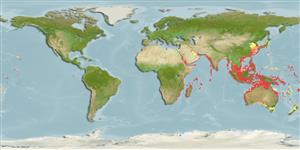Sepioteuthis lessoniana Férussac, 1831
Bigfin reef squid| Native range | All suitable habitat | Point map | Year 2050 |

|
| This map was computer-generated and has not yet been reviewed. |
| Sepioteuthis lessoniana AquaMaps Data sources: GBIF OBIS |
Classification / Names Common names | Synonyms | CoL | ITIS | WoRMS
Cephalopoda | Myopsida | Loliginidae
Environment: milieu / climate zone / depth range / distribution range Ecology
Demersal; brackish; depth range 0 - 100 m (Ref. 275). Tropical; 51°N - 48°S, 22°E - 155°W (Ref. 106950)
Distribution Countries | FAO areas | Ecosystems | Occurrences | Introductions
Indo-Pacific: from Japan to Australia and New Zealand coasts, from Hawaii to the East African coast, north to Red Sea and south to Madagascar. Introduced in the Mediterranean Sea.
Length at first maturity / Size / Weight / Age
Maturity: Lm ? range ? - ? cm Max length : 40.1 cm ML male/unsexed; (Ref. 121859); max. published weight: 1.80 g (Ref. 275)
Also caught by set nets and spears and jigs. Demersal neritic species (Ref. 105081). Inhabits warm coastal waters (Ref. 101164). Found among rock reefs, seaweeds and estuaries (Ref. 105081). Primarily active at night and is found in shallow waters, from 0 to 100 m in depth. Moves to deeper waters or in proximity to floating driftwood, reefs, rocks, or seagrasses during daylight (Also Ref. 129713). Often solitary (Ref. 101164). Voracious (Ref. 101165) and strictly carnivorous predator (Refs. 101164, 129713). Mainly consumes mollusks, fishes (Ref. 101164) and prawns (Ref. 101165). Utilizes its characteristic tentacles to catch live prey (Ref. 101164). Exhibits cannibalism on smaller conspecifics (Ref. 101164) or among size classes (Ref. 101165).
Life cycle and mating behavior Maturity | Reproduction | Spawning | Eggs | Fecundity | Larvae
Members of the class Cephalopoda are gonochoric. Male and female adults usually die shortly after spawning and brooding, respectively. Mating behavior: Males perform various displays to attract potential females for copulation. During copulation, male grasp the female and inserts the hectocotylus into the female's mantle cavity where fertilization usually occurs. Life cycle: Embryos hatch into planktonic stage and live for some time before they grow larger and take up a benthic existence as adults.
Main reference
References | Coordinator | Collaborators
Roper, C.F.E., M.J. Sweeney and C.E. Nauen. 1984. (Ref. 275)
IUCN Red List Status (Ref. 130435)
Data deficient (DD) ; Date assessed: 02 July 2014
CITES status (Ref. 108899)
Not Evaluated
CMS (Ref. 116361)
Not Evaluated
Threat to humans
Human uses
Fisheries: commercial
FAO - Fisheries: landings | FishSource | Sea Around Us
Tools
More information
Internet sources
BHL | BOLD Systems | CISTI | DiscoverLife | FAO(Fisheries: ; publication : search) | Fishipedia | GenBank (genome, nucleotide) | GloBI | Gomexsi | Google Books | Google Scholar | Google | PubMed | Tree of Life | Wikipedia (Go, Search) | Zoological Record
Estimates based on models
Preferred temperature
(Ref. 115969): 23 - 29.1, mean 28 (based on 2210 cells).
Resilience
(Ref. 69278):
High, minimum population doubling time less than 15 months (K=0.73-1.25).
Nutrients: Calcium = 126 [75, 177] mg/100g; Iron = 4.79 [1.67, 7.92] mg/100g; Protein = 15.5 [13.7, 17.4] %; Omega3 = 0.414 [0.262, 0.566] g/100g; Selenium = 57.8 [48.5, 67.2] μg/100g; VitaminA = 0 μg/100g; Zinc = 1.97 [0.92, 3.02] mg/100g (wet weight).



